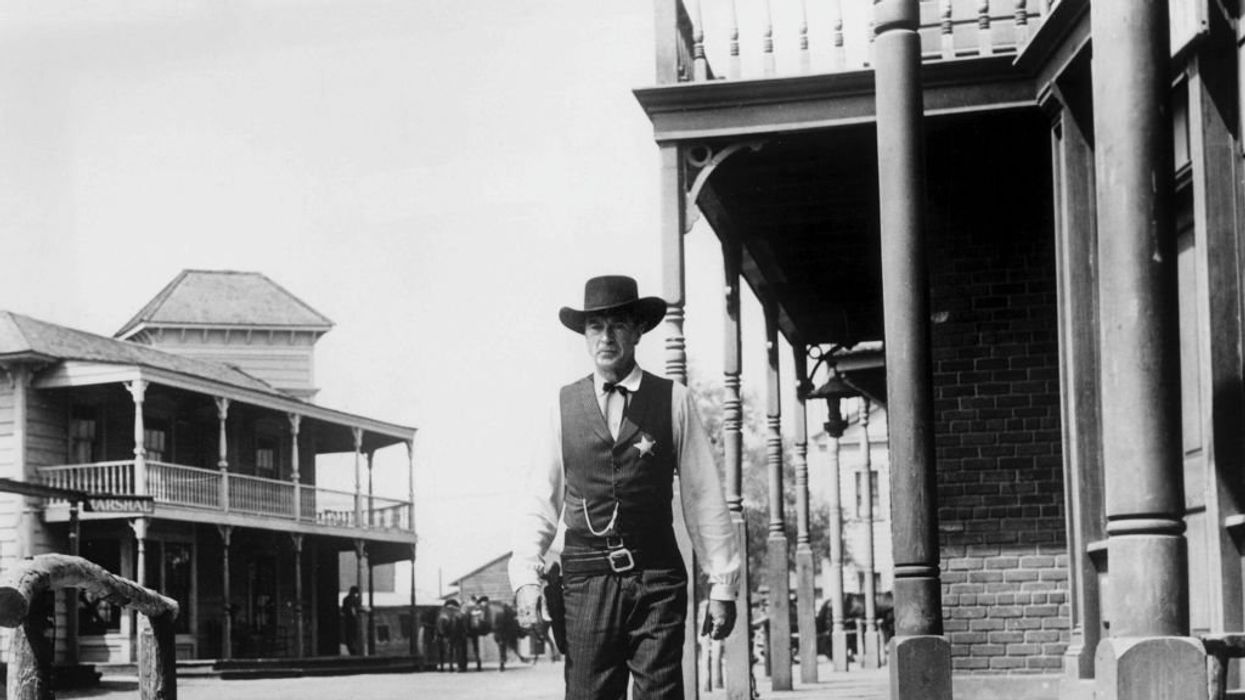
Getty Images/Silver Screen Collection

Our correspondent comes out guns a-blazin' with his inaugural Western pick.
The classic Hollywood Western comes from a simpler time when the wide-open spaces of the media had yet to be settled. You had your local cinema, the radio, and whatever TV stations you could catch with your rabbit ears.
Imagine the inconvenience and lack of options in such a barren landscape. Then again, imagine the freedom.
Sitting down to watch a Western is a great way to unscramble your brain after too much time online. The slower, more thoughtful pace hones your attention. The craftsmanship of American movie-making at the top of its game instills patriotic pride. And the reminder of how shared myths can unite people of disparate backgrounds into a nation provides a little hope for the future.
In a quiet town called Hadleyville, deep in the New Mexico territory, Marshal Will Kane (Gary Cooper) is getting married.
He embraces his wife, Amy Fowler, played by the resplendent Grace Kelly. Moments later, news arrives that the outlaw Frank Miller has been pardoned and will be arriving by train at noon. It was Kane who arrested Miller years ago and sent him off to be hanged. Now, Miller is out for revenge. His only purpose is to kill Kane and anyone who gets in his way.
Kane faces a choice: stay to protect Hadleyville or leave for his honeymoon.
The film’s reactionary political certitude is somehow enhanced by the revolutionary spirit of its stylistic approach.
"High Noon" was filmed to unfold in real-time, adding weight with every second that inches closer to noon. You can see the time running out as the train rumbles nearer.
Call this a crisis of love. What does Kane love more: his new wife or his old town?
Lloyd Bridges, father of “The Dude,” plays Deputy Marshal Harvey. A young Lee Van Cleef has a bit part that allows him to hone the character that would later show up in Sergio Leone’s spaghetti Westerns.
It’s no surprise that Marshal Kane is popular among several presidents. In fact, both Ronald Reagan and Bill Clinton, ideologically opposed, admire the Marshal.
His campaign of redemption is democratic, but it’s also guided by the authority of a wise lawman willing to swat away bad ideas only after having considered them as solutions to the looming disaster.
"High Noon" excels in every sense. The lighting, the costumes, the set design, the scenery — all remain true to the classic Western, which strengthens the movie’s anti-Western bent.
"High Noon" earned seven Oscar nominations and won four. Such commendation is somewhat surprising given the film’s staunch anti-communist themes.
One man’s duty to the autonomy of the individual, each individual, outranks any sort of collectivism or utilitarianism, any ideologies willing to sacrifice some for the good of the majority.
Kane evinces a moral code that is deontological — right and wrong are decided by the rules and laws and systems that adhere to objective morality, as given to us by God or nature or humanity or whatever force a person needs.
This, again, is anti-collectivist thinking. The film’s reactionary political certitude is somehow enhanced by the revolutionary spirit of its stylistic approach.
Kane's moral certainty deepens the longer he thinks about the situation. His battle is largely bureaucratic as he scours for enough men to form a defense force. But they won’t do it.
It’s outlandish! I mean, this man cannot find a willing volunteer for the life of him. Why? Why are the townspeople so unwilling to stand up to a tyrannical killer?
Kane has no time to linger on this question. He keeps going alone — but strong in his alienation, not weakened by it.
His encounters are deeply postmodern, absurdly never-ending in their hiccups and failures.
The townspeople want him to abandon the town. But then what? Flee from a thirsty psychopath and let the town deal with him? For how long?
At its most dramatic, "High Noon" has the sharp dialogue of a film noir classic and the violent mood swings of a Shakespearean tragedy. The characters waver between fear and alienation as the threat of the approaching murderer grows. With each minute, they burrow deeper into their hiding places, waiting for one man to save a town that might not be worth saving.